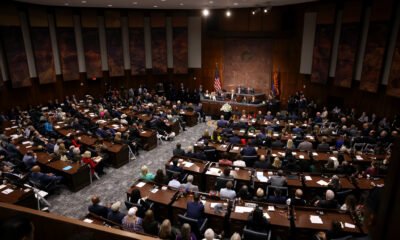arizona
Cunningham Delivers a Love Letter to Arizona’s Statehood

While Valentine’s Day is celebrated nationwide, Arizona marks a significant historical event on this date: Statehood Day. The state, which endured nearly fifty years as a territory, eventually joined the Union with complex social dynamics at play.
Arizona’s journey to statehood faced numerous challenges, many of which would be considered unacceptable today. Concerns included the large Native American and Hispanic populations, alongside fears of a potential Mormon resurgence from Mexico. These issues ultimately fell by the wayside, leading to Arizona’s statehood being established alongside neighboring New Mexico.
When statehood was granted in 1912, Arizona’s economy was anchored by its “five Cs”: copper, cattle, cotton, citrus, and climate. Particularly notable was the burgeoning wellness industry, marked by early resorts like Castle Hot Springs, which catered to those seeking the healing benefits of Arizona’s sunny climate.
Copper mining was the backbone of the economy, accounting for an estimated 81% of Arizona’s economic output by 1909. This reliance on copper underlined the importance of the mining sector during that era, setting the stage for growth and development.
The 1910 Census revealed a diverse population. Among the 204,854 residents of the Arizona Territory, there were 51,102 Mexican-born individuals, along with 20,650 citizens with Mexican ancestry. Additionally, the census recorded 29,201 Native Americans, who faced voting restrictions until 1948.
Despite the significant Hispanic presence in the legislative landscape just a generation prior, only one Hispanic member, Carl Jácome, contributed to the state’s Constitutional committee—signifying a disconnect between the population and political representation at the time.
The Constitution created at that time was deemed progressive, incorporating features such as recall elections, voter initiatives, and women’s suffrage. However, many of these elements were initially removed to secure statehood, only to be reinstated in subsequent elections.
In 1912, the largest cities were Phoenix and Tucson, with Bisbee surprisingly ranking third. The prominence of mining cities like Douglas and Globe further illustrated the industry’s influence on Arizona’s urban landscape, though technological advancements have since reduced mining’s role in employment.
As an Arizonan whose family relocated here during the post-World War II boom, I take pride in our state’s beauty and potential. It is crucial that we work toward a sustainable future for generations to come.
Happy Valentine’s Day, Arizona.

















